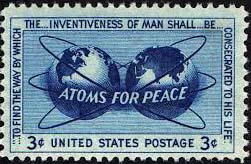
CWP Blog | CWP
Discussions with Deb: Fracking by Nuclear Explosion
July 5, 2019
July 5, 2019
CWP
CWP Blog
By: Deb Jerison
History is interesting and filled with fascinating twists and turns. One of my favorite topics is Atoms for Peace.
Atoms for Peace began in 1953 with a speech by President Eisenhower. It was supposed to showcase the non-military benefits of the US nuclear program to help reassure people that the US intended to use nuclear energy for the good of the people rather than just for military actions. Proposed projects included peaceful uses like creating harbors, canals, dams, road cuts through mountains and other construction projects by nuclear bombs. This was back in the day when the Atomic Energy Commission Commissioner Lewis Straus was promoting nuclear power as the coming thing and coined the phrase “electricity too cheap to meter.”
In 1958 the Atomic Energy Commission began the Plowshare Program, as part of Atoms for Peace. Dr. Edward Teller ran Project Plowshare, which lasted twelve years. The name, Plowshare, came from the Bible’s Isaiah 2:4 “He shall judge among the nations and will settle disputes for many peoples. They shall beat their swords into plowshares and their spears into pruning hooks. Nation will not take up sword against nation, nor will they train for war anymore.”
Two of the proposed projects were for extracting oil from tar sands/oil shale and extracting natural gas by nuclear explosion. Yep, fracking by nuclear explosion. The AEC really thought that would be a good idea! The Atomic Energy Commission, precursor to our Department of Energy, did several “gas stimulation” tests. In 1967 Project Gasbuggy was done near Farmington, New Mexico and Project Rulison was done in 1969 near Grand Valley, Colorado. These tests made the project seem feasible so in 1973 three 33-kiloton nuclear explosions were detonated simultaneously in Rio Blanco near Rifle, Colorado. It was a success in that it did release natural gas. However, the AEC was unable to sell the gas as no consumers wanted radioactive natural gas to power their homes or industries. Now workers from these sites are covered under the Energy Employees Occupational Illness Compensation Program (EEOICPA) because of the radiation and chemically induced illnesses caused by the explosions.
The Nevada Test Site reported that by 1974 about $82,000,000 had been spent trying to release natural gas by nuclear explosions. It was then determined that even if there were 25 years of natural gas production from the program only 15%-40% of the investment could be recovered.
